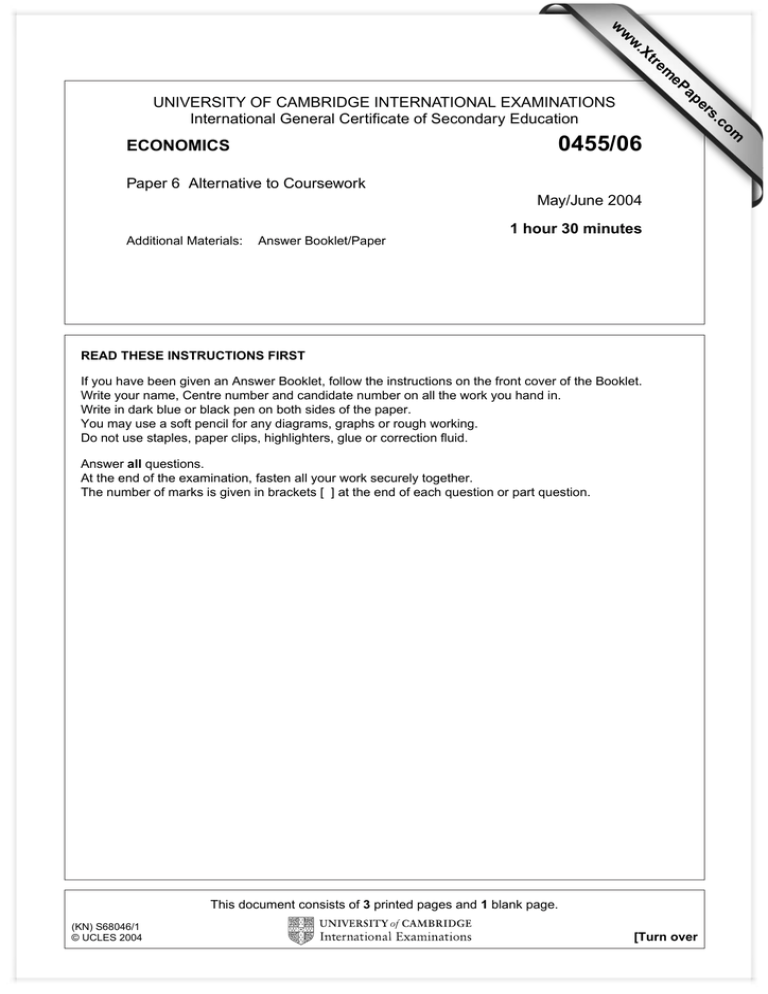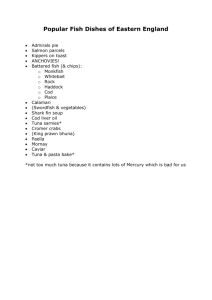UNIVERSITY OF CAMBRIDGE INTERNATIONAL EXAMINATIONS International General Certificate of Secondary Education www.XtremePapers.com
advertisement

w w ap eP m e tr .X w 0455/06 ECONOMICS Paper 6 Alternative to Coursework May/June 2004 1 hour 30 minutes Additional Materials: Answer Booklet/Paper READ THESE INSTRUCTIONS FIRST If you have been given an Answer Booklet, follow the instructions on the front cover of the Booklet. Write your name, Centre number and candidate number on all the work you hand in. Write in dark blue or black pen on both sides of the paper. You may use a soft pencil for any diagrams, graphs or rough working. Do not use staples, paper clips, highlighters, glue or correction fluid. Answer all questions. At the end of the examination, fasten all your work securely together. The number of marks is given in brackets [ ] at the end of each question or part question. This document consists of 3 printed pages and 1 blank page. (KN) S68046/1 © UCLES 2004 [Turn over om .c s er UNIVERSITY OF CAMBRIDGE INTERNATIONAL EXAMINATIONS International General Certificate of Secondary Education 2 1 Fishing in the UK Cod is a fish which is very popular as a food in the UK. By 2002, only 7% of the 240 000 tonnes bought each year was caught in the seas around the UK. This was because during the 1960s and 1970s intense fishing almost wiped out the stocks of cod in those seas. By 2002 the UK had to rely on imports of cod from Iceland, Norway and Russia. To overcome the need to import so much fish it was proposed in 2002 to breed cod on fish ‘farms’. A Norwegian-owned company began to develop a farm by constructing cages. Local people complained because they said the cages would destroy an area of natural beauty. The farm was intended to employ 25 people. The plan was for the farms to be developed slowly so that eventually they would be able to supply 24 000 tonnes of cod a year and employ 1600 people in an area where the rate of unemployment was high. The UK government saw this as an important move towards maintaining independence in the supply of the fish. Those who wanted to develop the farms saw them as a way to increase profitability in the fishing industry. Previously most of the farming of fish had been concentrated on salmon. Salmon is another fish which is popular in the UK. The farming increased output and, as a result, the price of salmon had fallen. This had caused profits to decrease. The developers of the cod farms also said that the farms would allow the stocks of cod in the oceans to recover and that, therefore, the farms would be a benefit to fishermen. The fishermen did not agree. They said that all farmed fish need to be fed and the food would have to be found in the fishing grounds that supplied other fish. This would cause problems because the food is limited. A spokesperson said ‘there is no point in talking about a recovery in the fishing industry if there is not enough food for the fish to eat’. (a) Calculate the amount of fish bought in 2002 that was caught in the seas around the UK. Show how you calculated the figure. [2] (b) What proportion of the UK total demand for cod would be produced by the fish farms if they produced all that was planned? [1] (c) Explain two advantages of establishing the fish farms. [4] (d) Explain with the help of a demand and supply diagram what has happened in the market for salmon in the UK. [4] (e) Explain what is meant by opportunity cost and identify an example of opportunity cost from the article. [4] (f) Discuss whether the cod farms would necessarily increase the profitability of the fishing industry as a whole. [9] [Total: 24] © UCLES 2004 0455/06/M/J/04 3 2 Economic Growth The following tables show figures for Gross Domestic Product for some African countries. Table 1 Real Gross Domestic Product Millions of US $ Constant 1995 prices Country Botswana Burundi Egypt Equatorial Guinea Ethiopia Namibia South Africa Zimbabwe 2000 1994-5 6 330 946 78 422 731 7 451 4 230 170 568 7 838 5.1 –7.3 4.7 14.3 6.1 4.1 3.1 0.2 1995 4 899 1 000 60 159 164 5 779 3 503 151 113 7 117 Table 2 % annual change in real GDP 1999-2000 3.4 –0.9 5.1 16.9 5.4 3.9 3.1 –4.9 (a) What is meant by economic growth? [3] (b) What is meant by the use of the word ‘real’ in Table 1? [2] (c) Consider the figures for Zimbabwe. Do those for the annual change in growth conflict with the figures for real gross domestic product? [2] (d) You have been told that economic growth brings great benefits and you decide that you would like to live in a country that had the biggest economic growth between 1999 and 2000. (i) Of the countries shown which one would this be? [1] (ii) What other information would you need in order to decide whether you would in fact be much better off in this country than any of the others shown? [8] [Total: 16] © UCLES 2004 0455/06/M/J/04 4 BLANK PAGE Copyright Acknowledgements: Question 1. Question 2. World Bank Database. © The Guardian. Every reasonable effort has been made to trace all copyright holders. The publishers will be pleased to hear from anyone whose rights we have unwittingly infringed. University of Cambridge International Examinations is part of the University of Cambridge Local Examinations Syndicate (UCLES), which is itself a department of the University of Cambridge. 0455/06/M/J/04



